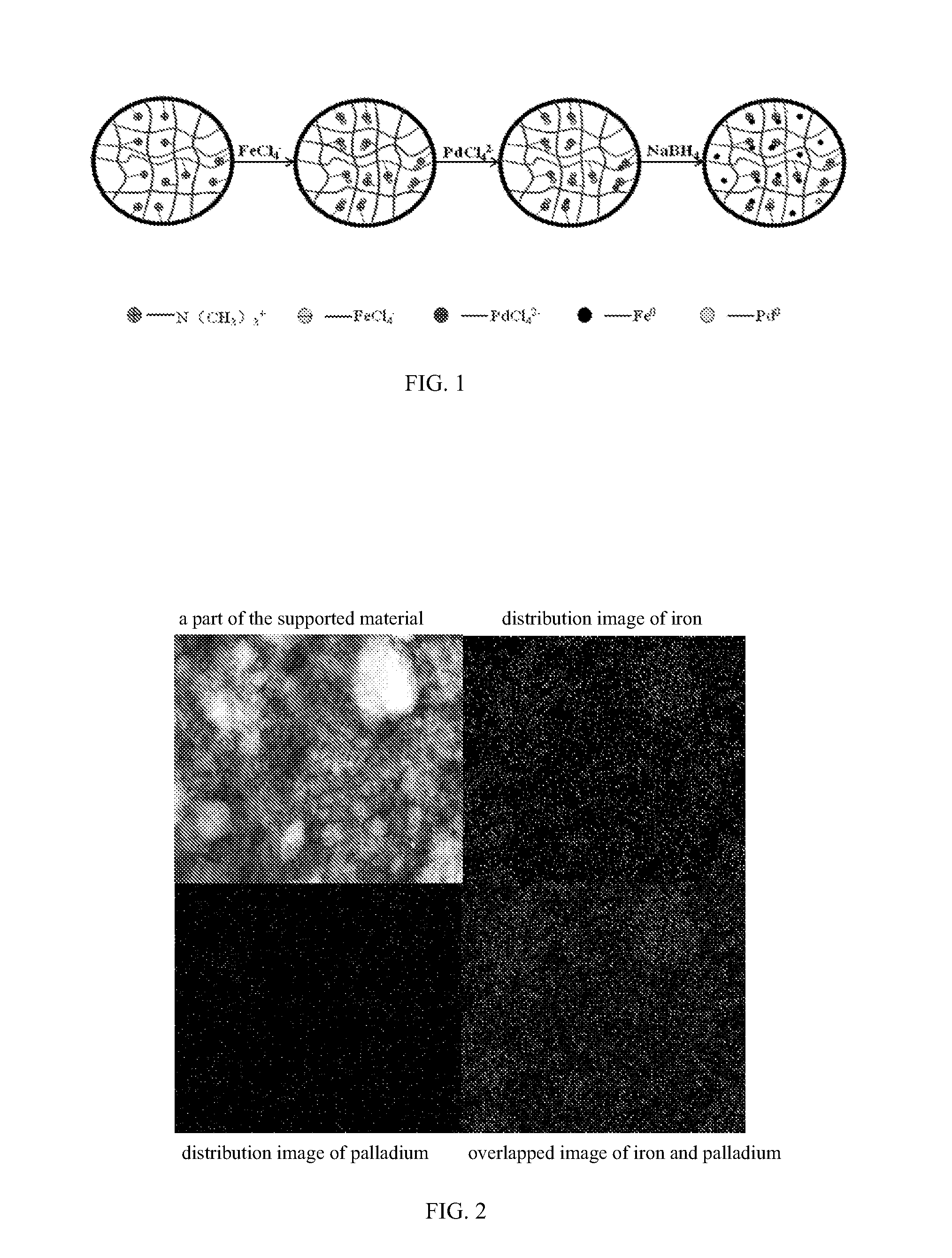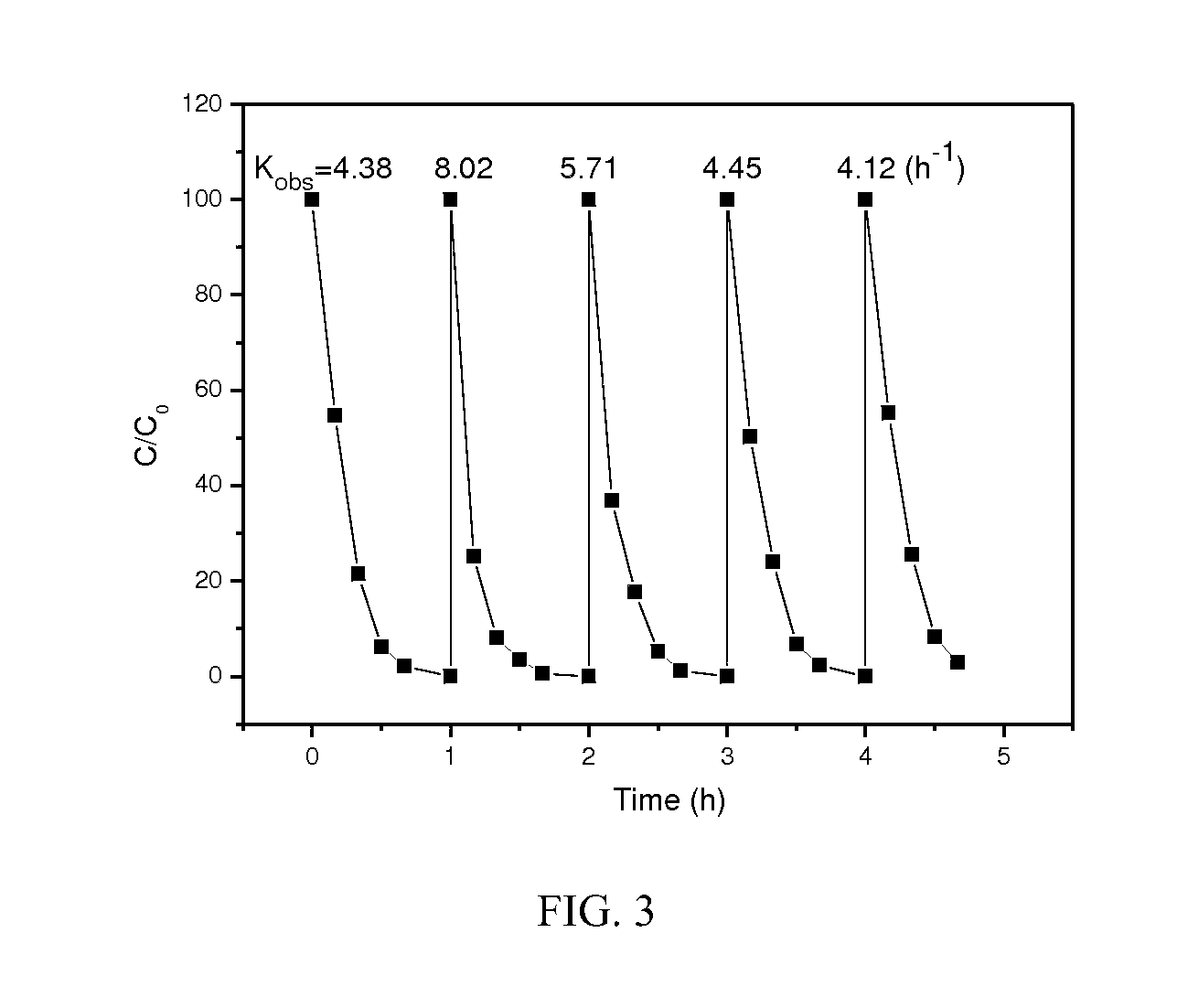Supported bimetallic nanocomposite catalyst and the preparation method thereof
a nano-composite catalyst and nano-composite technology, applied in the direction of organic compounds/hydrides/coordination complexes, catalysts, physical/chemical process catalysts, etc., can solve the problems of low efficiency and incompleteness, increased toxicity of degradation process, and higher toxicity of original pollutants
- Summary
- Abstract
- Description
- Claims
- Application Information
AI Technical Summary
Benefits of technology
Problems solved by technology
Method used
Image
Examples
embodiment 1
[0017]Using strong base anion resin D201 [containing quarternary ammonium groups, manufactured by (China) Hangzhou Zhengguang Resin Co., Ltd.] as the support, soaking it in saturated NaCl solution containing FeCl3.6H2O; the said solution contains 1 mol / L FeCl3, 2 mol / L HCl and saturated NaCl, and its solid-liquid ratio is 1:10. After 6 hours of oscillation reaction in a shaking incubator, washing the residual liquid off the resin surface with absolute ethanol and then adding in 0.05 mol / L Na2PdCl4 solution (solid-liquid ratio is 1:2); after 6 hours of ion exchange and then filtration, washing the resin 3 times with ethanol. Mixing the resin so obtained with 1 mol / L NaBH4 or KBH4 water solution (containing 10% ethanol by volume) for reaction under the condition of ultrasonic oscillation; keeping the mixing reaction till no bubbles popping out from the solution. When the reaction is complete, under the protection of nitrogen gas, filtering the mixture, transferring the resin and washi...
embodiment 2
[0019]Using weak base anion resin D301 [containing tertiary ammonium groups, manufactured by (China) Hangzhou Zhengguang Resin Co., Ltd.] as the support, soaking it in saturated NaCl solution containing FeCl3.6H2O; the said solution contains 1 mol / L FeCl3, 2 mol / L HCl and saturated NaCl, and its solid-liquid ratio is 1:10. After 6 hours of oscillation reaction in a shaking incubator, washing the residual liquid off the resin surface with absolute ethanol and then adding in saturated NaCl solution containing 0.1 mol / L CuCl2.2H2O (solid-liquid ratio is 1:2); after 6 hours of ion exchange and then filtration, washing the resin 3 times with ethanol. Mixing the resin so obtained with 2 mol / L NaBH4 or KBH4 water solution (containing 10% ethanol by volume) for reaction under the condition of ultrasonic oscillation; keeping the mixing reaction till no bubbles popping out from the solution. When the reaction is complete, under the protection of nitrogen gas, filtering the mixture, transferri...
embodiment 3
[0021]Using resin NDA-900 [containing amino groups, provided by (China) Jiangsu N&J Environmental Technology Co., Ltd.] as the support, soaking it in saturated NaCl solution containing FeCl3.6H2O; the said solution contains 1 mol / L FeCl3, 2 mol / L HCl and saturated NaCl, and its solid-liquid ratio is 1:10. After 6 hours of oscillation reaction in a shaking incubator, washing the residual liquid off the resin surface with absolute ethanol and then adding in saturated NaCl solution containing 0.2 mol / L NiCl2.6H2O (solid-liquid ratio is 1:2); after 6 hours of ion exchange and then filtration, washing the resin 3 times with ethanol. Mixing the resin so obtained with 3 mol / L NaBH4 or KBH4 water solution (containing 10% ethanol by volume) for reaction under the condition of ultrasonic oscillation; keeping the mixing reaction till no bubbles popping out from the solution. When the reaction is complete, under the protection of nitrogen gas, filtering the mixture, transferring the resin and w...
PUM
| Property | Measurement | Unit |
|---|---|---|
| pore size | aaaaa | aaaaa |
| mass fraction | aaaaa | aaaaa |
| mass fraction | aaaaa | aaaaa |
Abstract
Description
Claims
Application Information
 Login to View More
Login to View More - R&D
- Intellectual Property
- Life Sciences
- Materials
- Tech Scout
- Unparalleled Data Quality
- Higher Quality Content
- 60% Fewer Hallucinations
Browse by: Latest US Patents, China's latest patents, Technical Efficacy Thesaurus, Application Domain, Technology Topic, Popular Technical Reports.
© 2025 PatSnap. All rights reserved.Legal|Privacy policy|Modern Slavery Act Transparency Statement|Sitemap|About US| Contact US: help@patsnap.com



